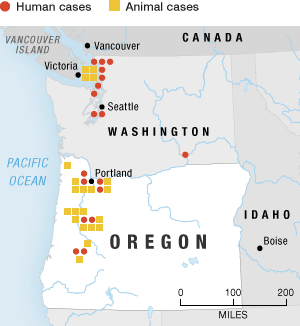TOP STORIES
 Fungal Disease Spreads Through Pacific Northwest
Fungal Disease Spreads Through Pacific Northwest
A rare and dangerous fungal infection named Cryptococcus gattii has been quietly spreading from British Columbia southward to the U.S. Pacific Northwest. And it's changing as it goes.
Researchers have discovered that a unique strain of the bug has emerged recently in Oregon and already spread widely there, sickening humans and animals.
. . . Researchers have also been struck by the array of different animals species getting infected. Domestic cats and dogs lead the list, but there have been confirmed reports in sheep, goats and horses, in elk and llamas, even in porpoises and dolphins whose infected corpses have washed up on beaches.
23 Aug 2010
R Knox
Photo credit: Public Library of Science/Edmond J. Byrnes III
>>>FULL ARTICLE
 Wildlife Health Bulletin #2010-03: White-Nose Syndrome: New Locations in Missouri, Tennessee and Quebec
Wildlife Health Bulletin #2010-03: White-Nose Syndrome: New Locations in Missouri, Tennessee and Quebec The USGS National Wildlife Health Center (NWHC) has detected the genetic signature of the fungus Geomyces destructans, the likely cause of white-nose syndrome (WNS), in skin samples collected from little brown bats submitted for testing from a cave in Pike County, Missouri and from White Oak Blowhole Cave in the Great Smoky Mountains National Park.
In addition, the Quebec Minister of Natural Resources has announced that WNS was detected in the Outaouais region of Quebec, and this finding was confirmed by the NWHC.
The Missouri and Great Smoky Mountain National Park sites are currently considered “presumptive positive” for WNS because the fungus was visible on the skin of bats and was confirmed by a molecular test (PCR), but there was no microscopic evidence of clinical fungal infection in the bats examined.
20 Apr 2010
Related News
>>>Illinois caves being closed to hamper spread of fungus deadly to bats
>>>White Nose Syndrome.mpg

New brucellosis 'hot spots' found in Yellowstone area
The animal disease brucellosis is emerging in new "hot spots" around Yellowstone National Park, according to new research that could complicate efforts to control transmissions of the disease to cattle.
Feeding grounds where food is left for elk as well as herds of bison inside the park have long been considered the main sources of brucellosis, which causes pregnant animals to abort their young.
But Paul Cross with the U.S. Geological Survey said a third source is now emerging: Blood tests indicate large elk herds living far from the feeding grounds have brucellosis exposure rates ranging from 10 percent to 30 percent.
24 Apr 2010
M Brown
>>>FULL ARTICLE
 Reported Wildlife Mortality Events to the USGS National Wildlife Health Center Updated
Reported Wildlife Mortality Events to the USGS National Wildlife Health Center UpdatedUSGS and a network of partners across the country work on documenting wildlife mortality events in order to provide timely and accurate information on locations, species and causes of death. This information was updated on April 23, 2010 on the USGS National Wildlife Health Center web page, New and Ongoing Wildlife Mortality Events Nationwide. Quarterly Mortality Reports are also available from this page. These reports go back to 1995.
26 Apr 2010
Area: United States
>>>Updated Wildlife Mortality Event Table
OTHER WILDLIFE HEALTH RELATED NEWS
Photo credit: Maricopa.com
 Enraged bobcat attacks dog, injures man - [rabies] Mammoth, Pinal County, Arizona, USA - Map It
Enraged bobcat attacks dog, injures man - [rabies] Mammoth, Pinal County, Arizona, USA - Map It 
- Shipping industry sends help as project in Panama tackles amphibian crisis
- Animal diseases in humans on the rise [Uganda]
- Dead lioness carrying anthrax buried in Hyderabad - Rani Bagh Zoological Garden, Hyderabad, Sindh Province, Pakistan - Map It

- Bivalves Alert Us to Oil Pollution: Mussel Power to Protect the Environment
- Zoos move to block foot-and-mouth [South Korea]
- Dugong killed in 'illegal' nets - Cairns, Queensland, Australia - Map It

WILDLIFE HEALTH RELATED PUBLICATIONS
Browse complete Digest publication library here.
 Characterization of a highly pathogenic avian influenza H5N1 clade 2.3.4 virus isolated from a tree sparrow
Characterization of a highly pathogenic avian influenza H5N1 clade 2.3.4 virus isolated from a tree sparrowVirus Res. 2010 Jan;147(1):25-9. Epub 2009 Oct 3.
Q Liu et al.
Aerial Attack Produces Reciprocal Fatal Trauma between Great Horned Owl and Red-Shouldered Hawk
Southeastern Naturalist. 2010; 9(1):179-180
S Boone et al.
Assessment and mitigation processes for disease risks associated with wildlife management and conservation interventions
Vet Rec. 2010 Apr 17;166(16):487-90.
M Hartley and E Gill
Synergistic effects of glyphosate formulation and parasite infection on fish malformations and survival
Journal of Applied Ecology. 2010; 47(2): 498 - 504
DW Kelly et al.
BioTorrents: A File Sharing Service for Scientific Data
PLoS ONE. 2010; 5(4): e10071.
MGI Langille and JA Eisen
OIE Bulletin - 2009
Issue 4




